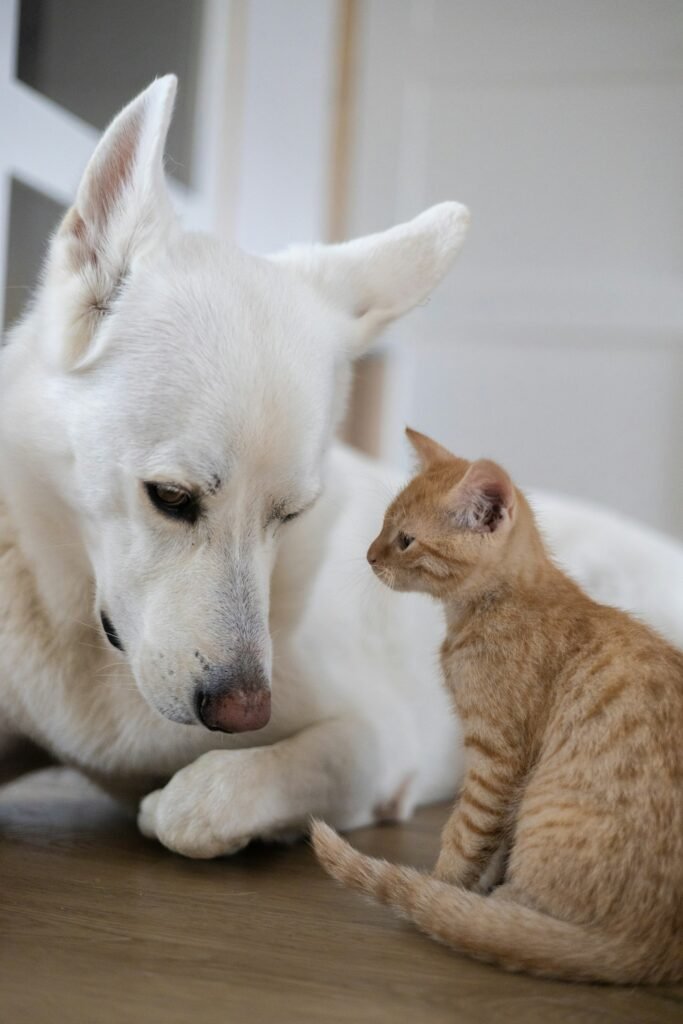Cats or dogs? It’s the big question, isn’t it? You’ve got cat people and dog people, each convinced their favorite furry friend is the better pet.
When it comes to training, though, the debate gets even spicier. Are dogs really easier to train, or is that just because they’re more obvious about it? And what about cats—are they trainable at all, or just little tyrants pretending to rule the house?
Let’s break it all down: the good, the bad, and the downright ridiculous of training cats and dogs.
Dogs: The People Pleasers

Let’s be honest, dogs want to make you happy. They live for it. That’s kind of their thing. If you’ve got a treat in hand and a cheerful tone, they’re like, “Say no more, I got this.”
Why are dogs generally easier to train? Let me spell it out:
- They love humans. Dogs are social animals. They naturally look to you for guidance because, in their heads, you’re the pack leader. (Feels good, doesn’t it?)
- They’re food-motivated. A slice of cheese, a tiny piece of chicken—boom, you’ve got their attention. You could probably teach them algebra with the right snack.
- They’re responsive. Dogs pick up on gestures, tone, and even facial expressions. If you’re happy, they’re happy.
But not all dogs are made the same. Some breeds, like Golden Retrievers or Border Collies, practically train themselves. Others, like Afghan Hounds, might stare at you blankly, thinking, Why should I?
Cats: The Rule Breakers

And then, there are cats. Oh, cats. They’re not exactly knocking down doors to make you proud. They do what they want, when they want, and for their own reasons. Training a cat can feel like negotiating with a tiny, furry dictator.
Here’s the thing, though—cats can be trained. It’s just different.
- Cats need motivation. And not just any motivation. Treats help, but only if they’re in the mood. (Good luck predicting that.)
- They don’t care about pleasing you. Harsh, but true. A cat will only follow commands if it feels like it benefits them in some way.
- Short sessions only. Cats get bored so fast. Five to ten minutes is about the max before they wander off or start licking their paw like, Is this over yet?
Let’s Compare the Two
Here’s a simple way to look at the differences between cats and dogs when it comes to training:
| Category | Dogs | Cats |
|---|---|---|
| Motivation | Food, praise, and affection | Treats or toys (if they feel like it) |
| Response to Commands | Fast and eager | Selective and slow |
| Attention Span | Longer, loves the attention | Short, prefers their own schedule |
| Ease of Learning Tricks | Fairly easy for most breeds | Takes time and creativity |
| Behavioral Training | Very trainable (e.g., no jumping on furniture) | Requires patience and redirection |
| Communication | Reads your tone and gestures well | Needs consistent signals |
Dogs might win in terms of enthusiasm, but cats bring their own unique challenges—and rewards—to the table.
How to Train a Dog

Training a dog? Honestly, it’s not rocket science. Here’s what you do:
- Start with basics. Focus on simple commands like “sit,” “stay,” and “come.” They’re the foundation for everything else.
- Use positive reinforcement. Treats, praise, belly rubs—dogs love all of it. Give them a reason to keep doing the right thing.
- Be consistent. Dogs thrive on repetition. Use the same word and gesture for each command, so they don’t get confused.
- Practice daily. Short training sessions (10–15 minutes) work best. Too long, and they might zone out.
- Level up slowly. Once they’ve mastered a command at home, test it in a park or somewhere with more distractions.
Dogs respond best to patience and clear communication. If they’re struggling, take a step back. They want to please you—they just need time to figure out how.
How to Train a Cat

Cats are a whole other vibe. Training them isn’t about dominance or obedience; it’s about collaboration. (Or tricking them into thinking it was their idea.)
Here’s how to work with your cat:
- Find what motivates them. Treats like tuna or Churu are usually winners, but toys might work too. Experiment until you find the jackpot.
- Keep it short and sweet. Training sessions should be 5–10 minutes max. Anything longer, and your cat will lose interest.
- Use a clicker. A clicker helps mark the exact moment your cat does something right. Pair it with a treat for maximum effect.
- Start small. Simple tricks like “sit” or “high-five” are good starting points. Gradually build from there.
- Stay chill. Cats can sense frustration. Keep the vibe light and fun, or they’ll check out faster than you can say “treat.”
With cats, progress comes in tiny steps. Celebrate every win, no matter how small.
Challenges You’ll Face
Dogs:
- Too much energy: Some dogs get so excited they can’t focus.
- Breed differences: While Labradors live to please, breeds like Beagles or Shiba Inus might require extra patience.
- Easily distracted: Squirrels, noises, smells—dogs can lose focus if something catches their attention.
Cats:
- Zero interest: If your cat isn’t feeling it, training is a no-go.
- Mood swings: Cats can go from playful to “don’t talk to me” in 0.5 seconds.
- Short attention spans: If you can hold their focus for more than 5 minutes, you’re basically a wizard.

When Cats Steal the Show
Let’s give cats their credit where it’s due. They might not be as eager as dogs, but they’ve got some unique perks when it comes to training:
- Cats are sneaky-smart. They’ll figure out how to open cabinets or solve puzzles faster than you think.
- Once a cat learns something, they rarely forget it.
- Training a cat feels like unlocking a secret—they’re not obvious about their intelligence, so it’s extra rewarding when they finally get it.
Why Dogs Take the Crown
For all their quirks, dogs are just easier to train overall.
- They love working with you, and training feels like teamwork.
- Dogs thrive on praise, so they’re happy to repeat behaviors that make you smile.
- Advanced training (like agility or search-and-rescue) is where dogs truly shine.
Which Pet Is Better for You?
If you want a pet who’s eager to learn, quick to respond, and loves structured training, a dog is probably your best bet. They’re all about pleasing you and will happily work for treats or praise.
If you’re looking for a more independent pet who’s a little mysterious (and okay, maybe a little sassy), a cat is a rewarding challenge. You’ll need patience, but the payoff is worth it.

Final Thoughts
So, cats vs. dogs: who’s easier to train? Dogs win in terms of obedience and speed. Cats, on the other hand, bring a unique sense of satisfaction to the training process.
In the end, it’s not about who’s easier—it’s about how you connect with your pet. Whether it’s a wagging tail after a perfect “sit” or a proud high-five from your feline overlord, the joy of teaching a trick is the same.
Whichever pet you choose, remember: training is as much about patience and fun as it is about the result. 😊




